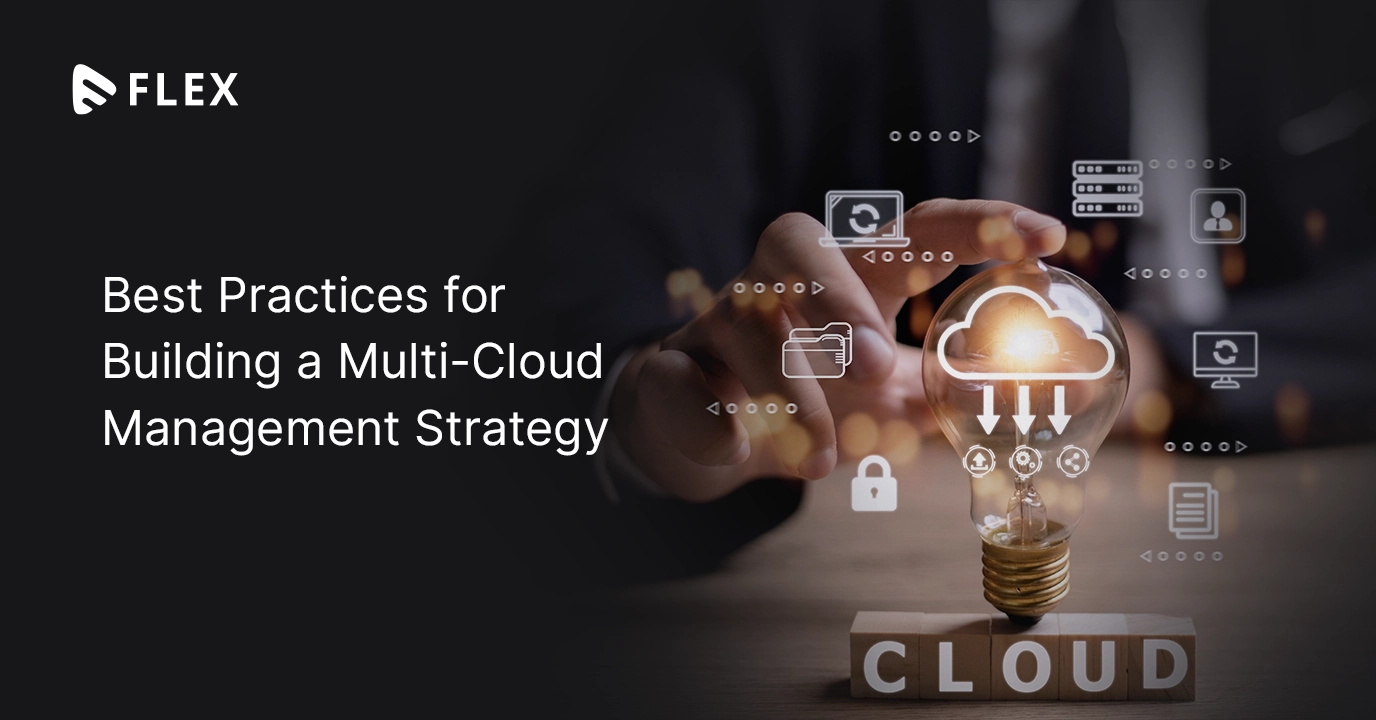In today’s rapidly evolving technological landscape, the cloud has become an essential tool for businesses of all sizes. However, with the increasing popularity of multi-cloud environments, managing these platforms has become a significant challenge for organizations.
A multi-cloud strategy involves utilizing two or more cloud services from different vendors, allowing companies to leverage the benefits of each platform while avoiding vendor lock-in.
While the advantages of a multi-cloud approach are clear, the complexity of managing multiple cloud environments requires a solid management strategy. Without a comprehensive plan in place, businesses risk losing control over their data, security, and cost management, among other critical aspects. That’s why implementing best practices for building a multi-cloud management strategy is crucial for ensuring a successful and sustainable multi-cloud environment.
In this article, we’ll explore the best practices for building a multi-cloud management strategy that can help your organization optimize its multi-cloud environment. So, let’s get started!
What Is Multi-Cloud?
Before we delve deeper into multi-cloud best practices, let’s know what it is. Multi-cloud refers to a strategy that involves using two or more cloud services from different providers to meet an organization’s IT requirements. Rather than relying on a single cloud service, a multi-cloud approach allows businesses to leverage the benefits of multiple cloud platforms while avoiding the potential drawbacks of vendor lock-in.
By distributing workloads across multiple cloud environments, companies can achieve greater flexibility, scalability, and resilience in their IT infrastructure. Multi-cloud also enables organizations to choose the best services and features from different providers to meet their specific requirements, from data storage and processing to application development and deployment.
However, managing multiple cloud environments can be complex and challenging, requiring careful planning and execution to ensure that the benefits of a multi-cloud approach are fully realized.
Did you Know? According to Statista, the worldwide public cloud services market is forecast to grow to US $881.80 billion by 2027?
To explore more details about the concepts of hybrid and multi-cloud environments and their differences, read our blog Multi-cloud vs Hybrid Cloud Solution.
Best Practices to Adopt for Building a Multi-Cloud Strategy
As organizations increasingly adopt multi-cloud strategies to achieve greater flexibility, scalability, and resilience in their IT infrastructure, effective multi-cloud management has become critical for ensuring the success of these complex environments.
In this section, we’ll explore six best practices for building a multi-cloud management strategy that can help your organization optimize its multi-cloud environment.
1. Select the Right Tools for Multi-Cloud Management
The first step in building an effective multi-cloud management strategy is to select the right tools for the job. With a range of cloud management platforms, cloud providers, and cloud orchestration tools available, it can be challenging to know where to start. The key is to choose tools that provide a unified view of your multi-cloud environment, allowing you to manage your cloud resources holistically.
- Cloud management platforms, such as AWS Management Console, Google Cloud Console, Jatheon Cloud and Microsoft Azure Portal, provide a single interface for managing your multi-cloud resources across different providers.
- These platforms typically offer a range of tools for monitoring and managing your cloud resources, such as dashboards, alerts, and automation tools.
- Cloud providers can help you optimize your multi-cloud environment by providing visibility into costs, performance, and security across different providers.
- Cloud orchestration tools enable you to automate the deployment and management of your multi-cloud infrastructure. These tools use declarative configuration files to define your cloud resources and infrastructure as code, allowing you to easily create, update, and delete resources across different cloud providers.
2. Implement Governance and Security Policies
As your multi-cloud environment grows, ensuring compliance with regulatory requirements and maintaining robust security become increasingly critical. Implementing governance and security policies can help you achieve these goals by providing a framework for managing and securing your cloud resources across different providers.
Cloud governance involves establishing policies and procedures for managing your cloud resources, such as defining who can create or delete resources and setting limits on resource usage. Implementing a cloud governance framework can help you achieve greater control over your multi-cloud environment and reduce the risk of unauthorized access or configuration changes.
Cloud security involves implementing measures to protect your cloud resources and data from unauthorized access, theft, or data loss. Implementing a multi-cloud security strategy can help you ensure that your data and resources are secure across different cloud providers. This can include implementing encryption for data at rest and in transit, establishing access controls, and monitoring your cloud environment for suspicious activity.

3. Establish a Multi-Cloud Cost Management Strategy
Managing costs is a key concern for any multi-cloud environment. Without a comprehensive cost management strategy in place, you risk overspending or incurring unexpected costs. Establishing a multi-cloud cost management strategy can help you optimize your spending and achieve greater cost efficiency.
One key best practice for multi-cloud cost management is to establish a centralized view of your cloud spending across different providers. This can help you identify areas where you may be overspending or underutilizing resources. Cloud management platforms and cloud providers can help you achieve this by providing detailed cost reports and analytics.
Also, you need to optimize your use of cloud resources across different providers. This can include rightsizing your cloud resources to ensure that you’re not paying for resources that you’re not using, or using reserved instances or spot instances to achieve greater cost efficiency.
Additionally, negotiating volume discounts or using cost-effective cloud services, such as serverless computing or object storage, can help you achieve cost savings in your multi-cloud environment.
4. Deploy a Resilient Multi-Cloud Architecture
Building a resilient multi-cloud architecture is critical for ensuring that your applications and services remain available in the event of a cloud provider outage or other disruptions. A resilient architecture involves designing your applications and services to be highly available and fault-tolerant.
One of the best practices for building a resilient multi-cloud architecture is to use multiple availability zones or regions within each cloud provider. This can help you achieve redundancy and mitigate the risk of a single point of failure.
Additionally, using multiple cloud providers can help you achieve even greater resilience by allowing you to distribute your workloads across different cloud environments.
Also, you can use load balancing and auto-scaling to ensure that your applications and services are always available and can handle fluctuations in traffic or demand. Load balancing distributes traffic across multiple instances of your application, while auto-scaling automatically adjusts the number of instances based on demand. This can help you achieve greater performance and resilience in your multi-cloud environment.
5. Build a Multi-Cloud Disaster Recovery Plan
A disaster recovery plan is critical for ensuring that your business can quickly recover from a major disruption, such as a cloud provider outage or a natural disaster. Building a multi-cloud disaster recovery plan involves identifying critical applications and services, establishing recovery objectives, and implementing a plan for recovering from a disaster.
It is a good practice to use a multi-cloud backup and recovery solution. This can help you achieve greater resilience by allowing you to store backups of your data and applications across different cloud providers. Additionally, testing your disaster recovery plan regularly can help you ensure that it works effectively and that you can recover from a disaster quickly and efficiently.
6. Select the Right Cloud Vendor
Last but not the least, if you want your business to deploy a successful multi-cloud strategy, first, you would have to scout for the right partner/cloud vendor that specializes in the implementation of a multi-cloud environment.
It is wise to select a cloud partner with proven experience in implementing multi-cloud management. Resource requirements, scalability options, ease of data migration and integration are some of the key aspects worth discussion before collaborating.
Muvi Flex helps businesses with both multi and hybrid cloud strategies to help you deliver better flexibility and portability for your data and applications while offering a range of competitive solutions like multi-DRM security, MRSS feeds, built-in scalable CDN, and many more.
For hosting your data and apps in a multi-cloud environment, try our 14-day Free trial, now!

FAQs
- What are the simple ways to control multi-cloud costs?
To control multi-cloud costs, you can start by monitoring your usage, setting budgets and alerts, optimizing workloads for cost-efficiency, leveraging automation tools, and negotiating with cloud providers for discounts.
- What issues can we have when managing a multi-cloud environment?
Managing a multi-cloud environment can lead to issues such as complexity in managing multiple providers, ensuring data security and compliance, integrating different cloud services, and managing costs across different platforms.
- What’s the most effective approach to multi-cloud budgeting?
The most effective approach to multi-cloud budgeting involves identifying your cloud usage patterns, establishing clear cost allocation mechanisms, setting budgets and limits, regularly monitoring and optimizing usage, and ensuring good communication between IT and finance teams.
- Which is an important factor when choosing a multi-cloud environment?
An important factor when choosing a multi-cloud environment is the ability to integrate with existing infrastructure and applications, as well as offering a diverse range of services and flexible pricing options that meet your business needs.
- What is the most important aspect of any multi-cloud network?
The most important aspect of any multi-cloud network is ensuring a high level of availability, performance, and security. This can be achieved by designing resilient architectures, leveraging automation and monitoring tools, implementing security best practices, and regularly testing and optimizing your network.















Add your comment